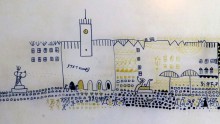Perfectly concise in form, but profound in content – this is what the creative work of Lviv artist Lesia Kvyk is like. With a single line drawn with a gel pen, she manages to convey a whole life-based story, which is philosophical, light, and cheerful at the same time.We met Kvyk in the Lviv cafe-gallery called “World of Coffee,” which is hosting an exhibition of her graphics. Leopolitans and guests of the city will be able to get acquainted with it till the end of May. This point should be especially emphasized, because Kvyk only rarely exhibits in Lviv.
A lady who came to greet the artist during our interview was very much aware of that fact. She came to look at the exhibition, although she could see a bit of Kvyk’s creative work every day. On her right hand, the lady had an elegant tattoo in the form of a line and a drawing, made by the artist. And after our conversation ended, Lviv translator and writer Andrii Sodomora also came to the cafe. He admitted having come solely to get a look at the exhibition. He is good friends with Kvyk, because she illustrated several of his books as a graphic designer. In particular, the artist received her second Grand Prix at the Publishers Forum in Lviv for designing The Hundred Riddles of Symphosius. She won this award for the first time in 2010, for the album Solomia Krushelnytska. And last year, connoisseurs of Kvyk’s creative work learned that she also worked with silk. Then the artist presented a collection of painted silk scarves, strikingly light and diverse in their colors.
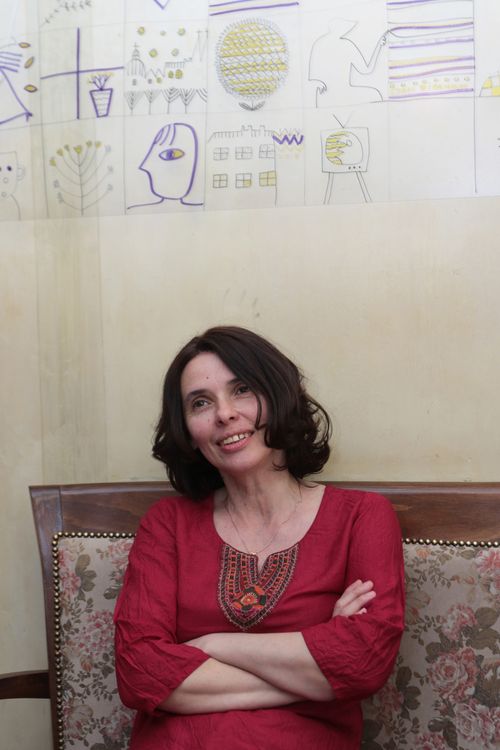
Where do you get your stories?
“From everyday life. I draw everything that happens. One just lives, and ideas are born spontaneously.”
By the way, how did you become an artist?
“I was drawing all the time, from childhood. I was doing it a lot and everywhere. But then, I just entered Solomia Krushelnytska Music School, where I studied piano. I stayed there until the 9th grade, thinking that I would be a pianist in the future. And then an accident occurred, which resulted in a broken finger. I did not play for a long time... However, I painted during all that time, and later I began to do it even more. I entered Trush College with a major in ceramics, and then went to Lviv Academy of Arts, also majoring in ceramics. So, I have been studying and painting all the time forever.
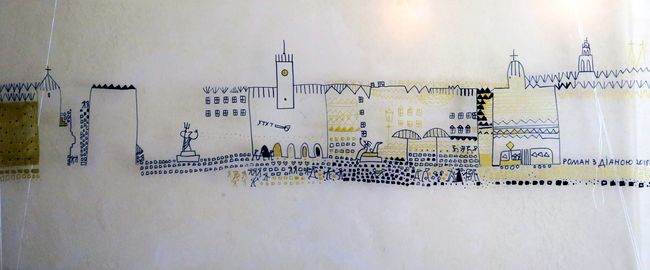
“I am a professional ceramicist. However, I cannot work in ceramics at the moment, I do not have enough time. Immediately after my graduation from the academy, a colleague invited me to work as a graphic designer, which I have actually done ever since.”
“ONE NEEDS TO GRASP AND DRAW THAT SPECIAL MOMENT”
You are able to notice comic things in everyday life. How do you manage to do it?
“I have such an outlook on things. For example, your photographer is picturing us right now. I would like to draw him. (Laughs.) With a big camera and a yellow watch. Provided I do not forget about it, I may well draw it tonight.
“There are a lot of funny things around us. One just watches and sees stories. One needs to grasp and draw that special moment.”
That is, the idea comes and you can immediately draw it, for example, while sitting on the nearest bench?
“That would be perfect. The idea has come, and there is a bench and a piece of paper next to me. But this is almost never the case. I need to preserve that mood and then release it on paper. And one can be influenced by that emotion for a whole day. I do graphic works with any gel pen I get. A drawing takes just a second... (Smiles.)
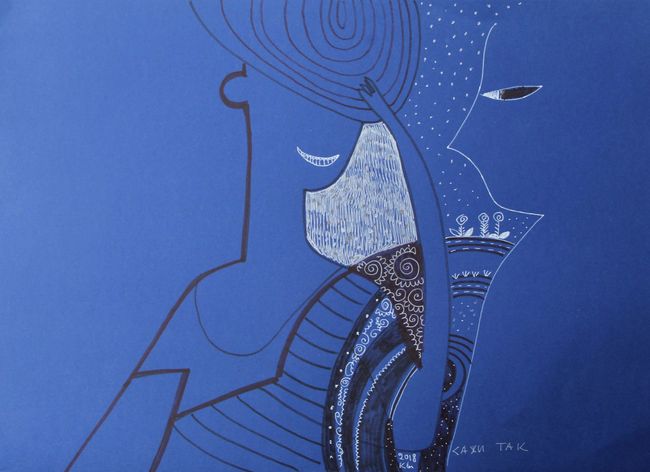
“I draw every day. Earlier, when my children were younger, I did it less frequently. Now I do it more. In general, if I do not paint for a long time, then there is an accumulation of energy that torments me. There is a need to express my thoughts, put the idea on paper. Therefore, I cannot help but draw.”
Regarding your art, where do you prefer to draw?
“I have an easel and the rest of the accessories at home. I feel very fortunate when I can get outdoors and draw from nature. However, this happens so rarely that I can count such occasions on my fingers. Although I really love drawing flowers from nature.
“By the way, my sister yesterday watered flowers in her little garden while wearing a large pink skirt and using a large green watering can. I will definitely draw it. That emotion should be preserved and conveyed to paper. The drawing will depend on how much this emotion persists. If it is conveyed well, then one will feel it when looking at the work. Meanwhile, if the artist starts to invent and belabor something, it will not turn out true. Often this happens when one wants to sell a work and begins to invent something to suit people’s tastes.”
You finalize most works with a concise signature, which becomes a full-fledged component of the story. Do these phrases come to your mind at the end of the work? Or do you draw and write at the same time?
“It depends. For the most part, I finish a drawing and a phrase is born at that very moment. If one can relax and read a drawing, the name comes on its own. If you cannot read it, then let someone close by to complete writing or drawing it, if they can read it. (Smiles.)”
“THE LEOPOLITANS ARE THE GREATEST TREASURE OF LVIV”
“Our clear-cut forests are coming back to us with terrible winds,” “We would like a few magnolias...” The theme of nature and environment is often present in your work. Why do you do it?
“It should be present in everyone’s mind. And above all, it should be present in the minds of those people who can influence it.
“I think that one hundred or three hundred years ago, Lviv was sometimes covered with sand just as it is today. But then Lviv was planted with trees, so Leopolitans never had to deal with sand on their teeth. And now everything is so small... They have planted such small trees in such big pots. This is ridiculous.
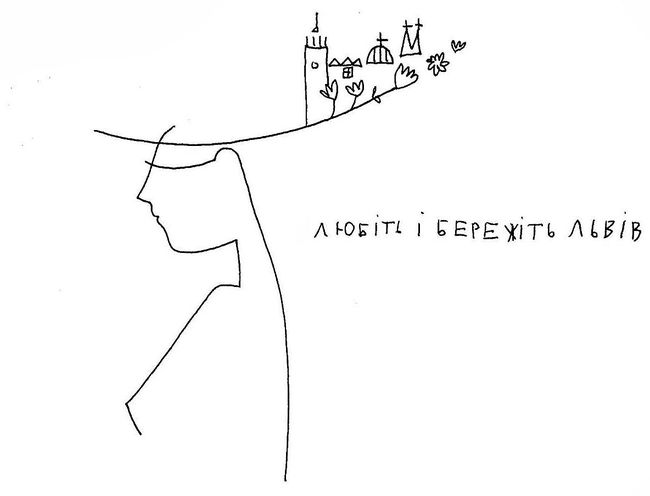
“They destroy a lot of things in the city... I have to draw a picture showing an angel sifting a city. I will name it Lviv Being Sifted. (Laughs.) It occurred to me during a walk yesterday.
“In principle, I like the fact that we have a lot of tourists. It is good. After all, this gets some people jobs. However, we have a lot of artificiality in the city. Those chocolates, souvenirs... Yes, this aligns with the best world practice of beautiful cities. But there should be some limit on it. I always think that we will assimilate all these people, that is, tourists and newcomers. After all, we Leopolitans are stronger.”
Recently, an exhibition entitled “Rescued Treasures of Underground Lviv” has opened at the Biskupin Archaeological Museum in Poland. Its artistic section features, in particular, your works...
“I greatly respect our archaeologists and support their endeavors. We, together with other artists, drew them as they were excavating in Mickiewicz Square. We drew from nature. I remember that there was terrible heat then. However, our archaeologists are very determined people. It was interesting. And in the drawings, one could then see Mickiewicz and his companion angel soaring over all those excavations.
“In general, archaeologists and other researchers need to be supported so that we can preserve something that has not got concreted over and spoiled yet. But... To reveal all the underground secrets of Lviv, one would need to dig it up all over. (Laughs.)
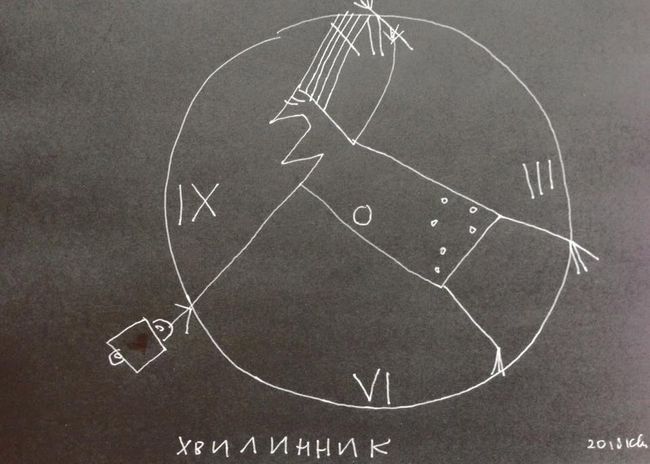
“Moreover, my dream is to see a museum of Lviv history appearing in the city, so that Poles could learn when they dominated the city, and the Muscovites could learn when they were in power here, and they all could realize that there were periods in the history of Lviv when none of them was present.
“I am a patriot of Lviv, born in this City of Lion. I walk down its streets every day, and all this is natural to me. So I draw it too.”
And what are, in your opinion, modern treasures of Lviv?
“The Leopolitans are the greatest treasure of Lviv. It must be preserved.”
“EVERY BOOK I DESIGN, I LIVE THROUGH AND TAKE IN MY SOUL”
And now let us talk about books...
“Frankly, I never thought I could make a book. While studying at the Academy of Arts, I had an opportunity to attend a computer graphics course free of charge. Then I thought I did not need this. It all seemed artificial and empty. But now I am very happy with the fact that I can do books that I like. I can draw, design, and typeset them. I won the Publishers Forum Grand Prix twice. The awards do not mean much for me, but it is nice to see a book winning after its creation involved a large number of people.”
Tell us, please, in more detail about the process of artistically designing a book. For example, how is it to illustrate the works of Sodomora?
“Such a work takes about six months. Before starting it, one needs to penetrate into the book’s meaning. Every book I design, I live through and take in my soul.
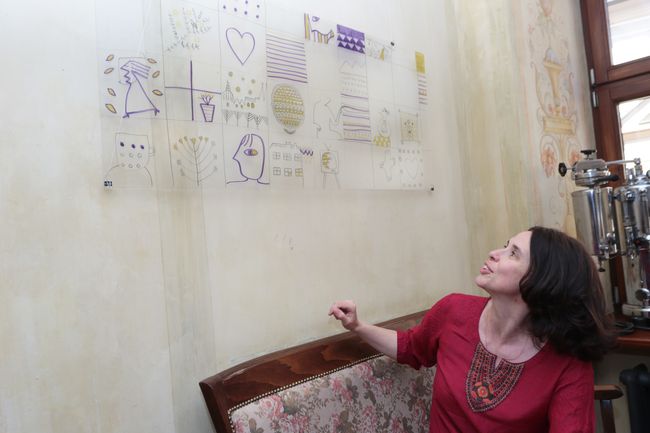
“Sodomora is a genius, no doubt about it. I will tell you more, we have already drawn illustrations to his new book which has not yet been published. I am enchanted by this book. In order to comprehend the depth of Sodomora’s thought in full, one must be very smart. Knowledge of Latin, Ancient Greek, his wisdom... All this he carries inside, but also generously shares with people. I have been very fortunate to be Sodomora’s contemporary and work with him.”
You also worked on publications devoted to Andrei and Klymentii Sheptytskys...
“The Sheptytsky family was truly aristocratic. The photo album Blessed Is the Man..., devoted to Andrei Sheptytsky, appeared three years ago. I deliberated for a long time whether to take up this job. After all, I did not know enough about Sheptytsky. In general, I am not sure if any Leopolitan can write a proper biography of Sheptytsky. He was a majestic figure, which should be written about and popularized. If it were not for Sheptytsky, then we would not have survived. The album had a very small print run, given the scale of this figure. It was only a thousand copies, which were distributed to libraries, educational and religious institutions.
“Last year, Klymentii Sheptytsky’s letters were published (I mean the album Blessed Archimandrite Klymentii (Count Kazymyr Sheptytsky). Letters to Brother Count Stanislaw Szeptycki and His Family). Even if a person who stands far away from the church and religion happens to read these letters, they will surely understand this sublime love between the brothers. Such books should be read, even if only a little bit daily.”
“GRAPHICS EMBROIDERED ON SILK”
An artist who works in an applied field, such as illustration or design, has to deal with clients. How far have you been able to combine your own creative vision and client requirements? Have you ever had some disagreements? How have you solved them?
“In design, I have to adapt to the client, for example, taking into account some corporate colors, a certain vision...
“There have been disagreements, especially when it comes to books. Honestly, there is such a tendency that the more money an individual has, the more aggressively they insist on their own vision. However, sometimes, when there is high trust in the artist, there are no problems at all. In the end, one should always be able to combine the client’s wishes with one’s tastes.”
And last but not least: you create artworks not only on canvas or paper, but also, for example, on silk, which came as a surprise to many connoisseurs of your creativity at the time. What new creative secrets are to be revealed by you soon, Ms. Kvyk?
“I like to draw on silk. However, it is quite expensive as a material. And in general, I draw on what I buy. An applied artwork is always better than just a picture. This is essentially the same graphics, only embroidered on silk.
“What are my plans for the future? I had an idea once of drawing some designs on a bedding set made of soft silk. The collection was to be called Do Not Sleep Alone. It is always interesting to sleep on something funny and silky. Actually, I already drew my designs on pillows, blankets, and sheets. However, I have effectively gifted away that whole prospective exhibition, since all our colleagues celebrated major anniversaries last year. It would be nice to somehow still implement this plan.”


